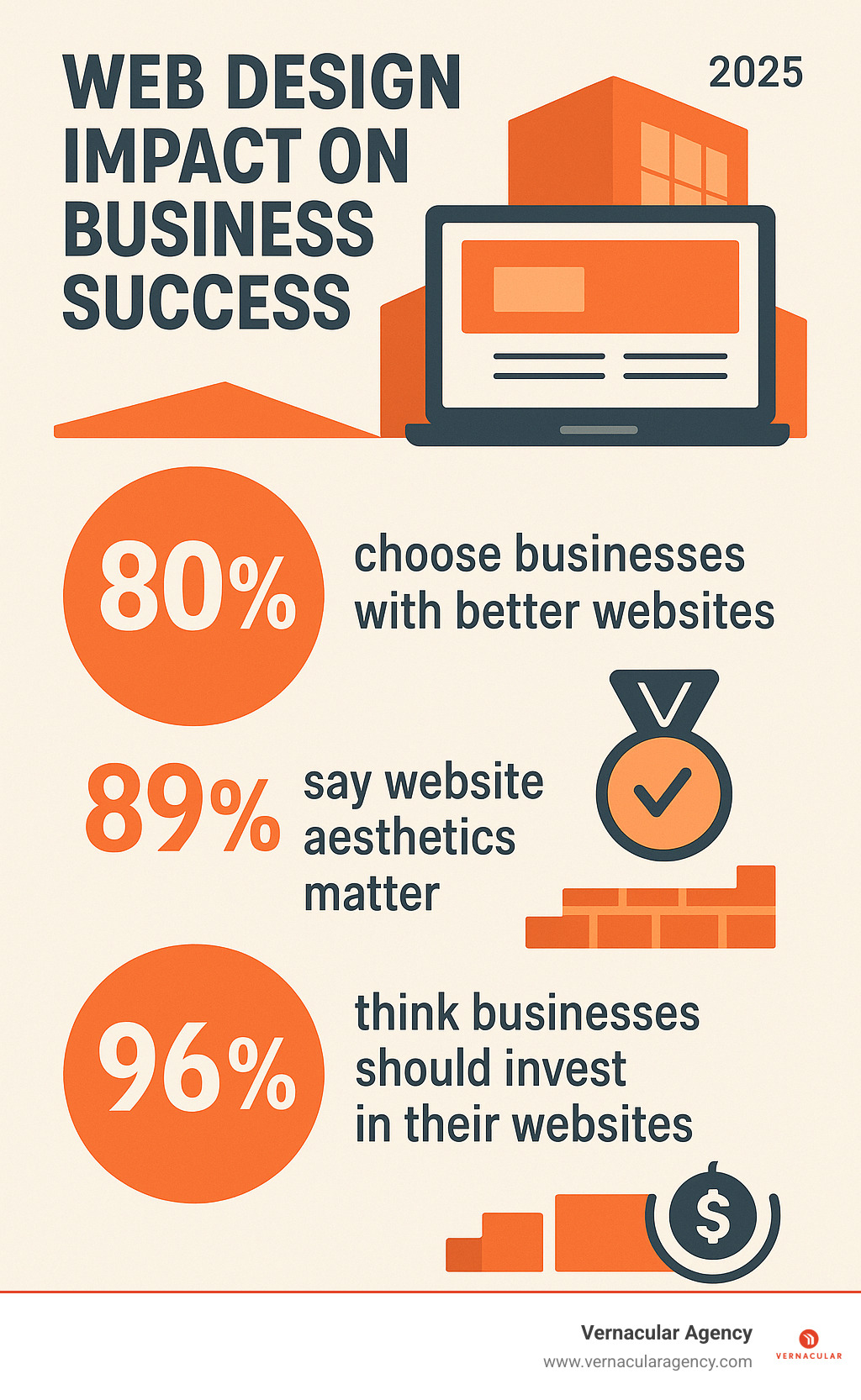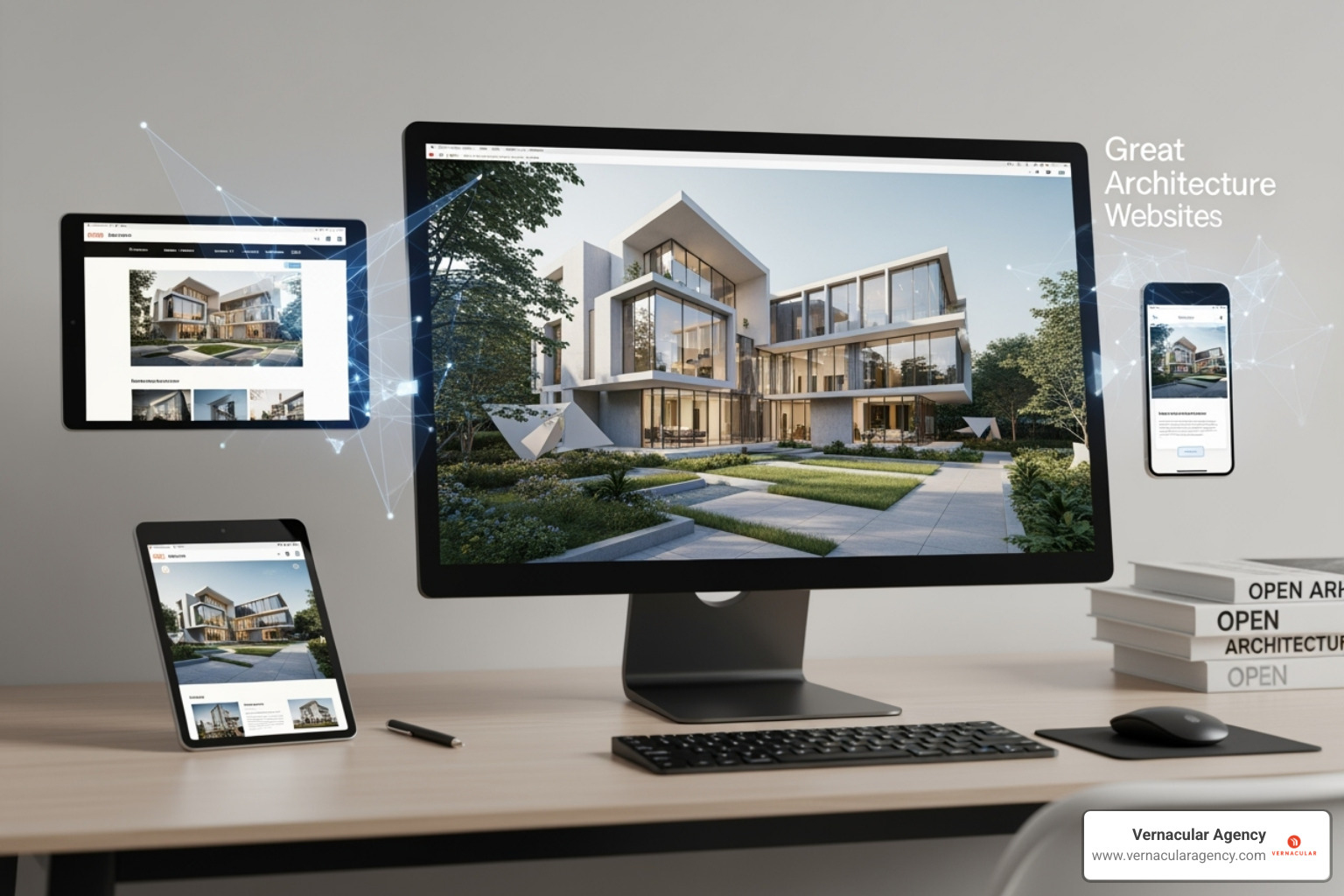Great architecture websites are the digital equivalent of a firm's most impressive building - they need to captivate visitors instantly while delivering flawless functionality. Here are the top categories that define exceptional architecture websites:
The Minimalist Masters: Clean, simple designs that let the work speak for itself
Immersive & Interactive Experiences: Sites that engage visitors through dynamic elements
Visual-First Storytellers: Portfolios that showcase work through compelling narratives
Research shows that 80% of consumers choose businesses with better websites, and 96% believe website investment should be a priority. For architecture firms, your website isn't just a digital brochure - it's your most powerful tool for attracting clients and top talent.
As Rebecca Falzano, Creative Director with nearly 15 years of experience guiding content creation and design, I've seen how great architecture websites can transform a firm's digital presence and business outcomes. My background in shelter magazine editing and collaborative storytelling has taught me what makes architectural content truly resonate with audiences.

Great architecture websites terms you need:
You know that feeling when you walk into a perfectly designed space? Everything just clicks - the lighting, the flow, the way each element serves a purpose while looking effortlessly beautiful. That's exactly what happens when you visit one of the great architecture websites.
But here's the thing: stunning visuals alone don't make a website great. Gorgeous project photos are essential (we're talking about architecture, after all!), but the real magic happens when design, functionality, and user experience come together seamlessly. It's like designing a building - every element needs to work in harmony.
The best architecture websites feel as thoughtfully designed as the buildings themselves. They're clean, simple, and fast - because nobody wants to wait around for a page to load, especially when they're eager to see your latest project. As ArchDaily editors note after reviewing hundreds of sites, "organization and simplicity" are what separate the good from the great.
Think of your website as the digital equivalent of a beautifully functional building. Every button, every image, every piece of content should serve a purpose while contributing to the overall experience. For more insights on achieving this balance, check out our guide on Website Design for Architects.

Let's be honest - when someone lands on your architecture website, they notice the visuals first. High-quality imagery is non-negotiable. We're talking about crisp, professional photos that showcase your work in its best light. Pair that with sophisticated typography that's easy to read and a layout that gives your projects room to breathe.
But beauty without brains? That's just frustrating. The most stunning website falls flat if visitors can't find what they're looking for. This is where intuitive navigation becomes your best friend. Your site should guide users effortlessly through your portfolio, almost like a well-designed building guides people through its spaces.
Fast load times are absolutely crucial. Think about it - if someone's exploring your visually-rich architecture site and it takes forever to load, they'll bounce faster than you can say "sustainable design." A seamless user journey keeps people engaged and tells them more about your practice than any amount of copy ever could.
The smartest firms use interactive elements and subtle animations to reflect their design philosophy. A minimalist firm might accept clean, uncluttered layouts that embody "less is more." An innovative studio might feature dynamic, experimental web design that mirrors their boundary-pushing architectural approach.
Your website isn't just a digital portfolio - it's your brand voice speaking directly to potential clients and collaborators. This goes way beyond slapping your logo on a page. We're talking about your entire online presence reflecting your company ethos and design philosophy.
Does your firm specialize in sustainable design? Your website should highlight those eco-friendly materials and regenerative design principles. Known for pushing architectural boundaries? Your site's design should feel cutting-edge and experimental, just like your buildings.
The great architecture websites excel at projecting quality and differentiating from competitors. They use visual style, content structure, and even the site's functionality to tell their unique story. This approach builds trust with visitors and becomes a powerful tool for promoting brand awareness.
Your website becomes a digital hub that showcases accomplishments to potential clients, inspires loyalty among current ones, and even attracts top talent to your team. It's your chance to show - not just tell - who you are and what you stand for. For more on integrating your brand strategy into your online presence, explore our insights on Digital Strategy for Architecture Firms.
Now that we've covered the theory, let's explore some real-world examples that bring these principles to life. These great architecture websites aren't just digital portfolios—they're carefully crafted experiences that showcase how leading firms use their online presence to communicate their vision and attract the right clients.

Sometimes the most powerful statement you can make is knowing what to leave out. The best minimalist architecture websites prove that less really is more—they use clean layouts, plenty of white space, and laser focus on the work itself.
Take John Pawson's site, for example. It's as pure and uncluttered as his architectural philosophy. Every element serves a purpose, and there's not a single unnecessary distraction from his stunning projects.
SANAA takes a similar approach, creating a tranquil digital space that mirrors their architectural values. Their website feels like walking through one of their serene buildings—calm, purposeful, and beautifully composed.
Foster + Partners demonstrates how minimalism can work even for firms with massive portfolios. Their sleek navigation and stunning imagery prove you don't need bells and whistles to make an impact. Sometimes the most effective way to showcase brilliance is to strip away everything that doesn't serve the work.
These great architecture websites understand that in a world full of digital noise, simplicity can be revolutionary.
On the flip side, some firms accept cutting-edge web design to create truly captivating digital experiences. These sites use dynamic elements, engaging animations, and interactive features to pull visitors into their world.
Zaha Hadid Architects' website matches their groundbreaking architectural vision with bold visuals and innovative presentations. It's impossible to visit their site without feeling the same sense of wonder you'd experience seeing their buildings in person.
BIG (Bjarke Ingels Group) pushes boundaries online just like they do in their architecture. Their creative layouts and unconventional navigation feel playful yet purposeful—much like their approach to solving complex design challenges.
Snøhetta's website beautifully showcases their multifaceted design process, using stunning visuals to highlight their commitment to sustainability and landscape integration. Every scroll reveals new layers of their thoughtful approach.
The Olson Kundig site exemplifies how video backgrounds and 3D scrolling effects can guide users through an immersive journey. These interactive elements don't just look cool—they help communicate the firm's innovative spirit.
For more insights on leveraging these digital strategies, check out our guide on Digital Marketing for Architecture & Design Studios.
The best architecture websites don't just show projects—they tell the stories behind them. These sites use high-quality photography, detailed project descriptions, and often include process sketches and technical drawings that give visitors deeper insight into the work.
Herzog & de Meuron excel at presenting comprehensive project details alongside stunning imagery. Their site gives you a complete understanding of their innovative building practices, from initial concept to final execution.
Studio Gang's website beautifully reflects their commitment to creating spaces that improve people's lives. Every project presentation emphasizes their eco-friendly and egalitarian design values, making their mission crystal clear.
MVRDV matches their cutting-edge architectural approach with equally innovative web layouts. Their site proves that a portfolio can be both highly informative and visually dynamic.
The Foster + Partners site stands out for its user-friendly approach to organizing a vast portfolio. They've mastered the art of making complex information accessible, with clear filtering options that let users sort projects by location, program, or timeline.
This filtering capability is crucial for firms with extensive portfolios. When users can easily steer through decades of work, they're more likely to find projects that resonate with their needs—and that's exactly what these great architecture websites accomplish.
Think of building a great architecture website like designing your most important project. You need a solid foundation, thoughtful planning, and careful attention to what works—and what doesn't. After reviewing hundreds of architecture websites, we've identified the key elements that separate the exceptional from the merely adequate.

Every successful architecture website shares certain fundamental features. These aren't just nice-to-haves—they're essential building blocks that determine whether visitors stay, explore, and eventually become clients.
Clear navigation forms the backbone of any effective site. ArchDaily's editors, who review hundreds of sites weekly, consistently emphasize "organization and simplicity" with "clearly worded navigation menus." Your visitors should never feel lost or confused about where to go next.
Comprehensive project pages showcase your work in the depth it deserves. Each project needs its own dedicated space with high-resolution images, detailed descriptions, and relevant project data like completion dates and locations. Consider including both stunning photographs and technical drawings side-by-side—this combination shows both the beauty and substance of your designs.
Your firm profile and philosophy section tells your story beyond the buildings. This is where potential clients connect with your brand on a personal level. What drives your design decisions? What makes your approach unique? This narrative helps visitors understand not just what you build, but why you build it.
Team biographies put faces to the talent behind your firm. People hire people, not just companies. Showcasing your team members with professional photos and thoughtful bios builds trust and highlights the expertise visitors can expect to work with.
Clear calls-to-action guide visitors toward the next step. Whether it's "Contact Us for a Consultation" or "Explore Our Portfolio," make it obvious what you want people to do. Don't make them guess how to get in touch or learn more.
A blog or news section serves double duty—it positions you as a thought leader while keeping your content fresh for search engines. Share project updates, industry insights, and firm news. This ongoing content creation is crucial for SEO success, as outlined in our guide on SEO Strategies for Architects' Websites.
For firms with extensive portfolios, project filters and search functionality become essential. Reddit discussions consistently highlight how users value effective sorting options—by project type, location, completion date, or size. This feature transforms a potentially overwhelming portfolio into an organized, explorable resource.
You'll find more detailed guidance in our comprehensive resource on website design for architects and engineers.
Just as architectural styles evolve, web design standards change rapidly. What impressed visitors five years ago might drive them away today. Understanding these common pitfalls helps ensure your site remains professional and engaging.
Slow load times top the list of user frustrations. ArchDaily editors and Reddit users consistently cite sluggish sites as deal-breakers. Users expect pages to load in seconds, not minutes. Optimize your images, streamline your code, and invest in reliable hosting—because patience isn't a virtue when it comes to web browsing.
Non-mobile-responsive design is no longer optional. With more people browsing on phones than desktops, your site must look and function perfectly on every device. If visitors have to pinch and zoom to read your content, they'll quickly move on to a competitor.
Confusing navigation defeats the purpose of having a website. Avoid overly creative or "gimmicky" navigation that prioritizes flash over function. As one industry expert noted, "hard-to-steer layouts" consistently frustrate users who just want to find information quickly.
Autoplaying music or video ranks among the most universally disliked features. It's startling, intrusive, and often inappropriate for the setting where someone is browsing. As one Reddit commenter bluntly put it, auto-playing sound is "tacky/annoying."
Low-quality images undermine your professionalism faster than almost anything else. Your architectural work deserves to be showcased with crisp, well-lit, high-resolution photography. Pixelated or poorly composed images suggest a lack of attention to detail that clients will notice.
Outdated information signals neglect and unprofessionalism. Broken links, old news, or projects that haven't been updated in years make visitors question whether your firm is still active or relevant.
"Intro" or "Splash" pages create unnecessary barriers to entry. Those "Click here to enter" pages from the early 2000s are not just outdated—they're counterproductive. As ArchDaily succinctly notes, "An 'Intro' Button. So 90s."
Illegible fonts and backgrounds prioritize style over substance. Choose typography and color combinations that improve readability rather than hinder it. Your content is too valuable to hide behind poor design choices.
By focusing on user experience and avoiding these common mistakes, your firm can create a digital presence that truly supports your business goals. For deeper insights into what makes architecture websites genuinely useful, explore the comprehensive analysis from ArchDaily on useful websites.
Building a great architecture website raises many practical questions for firms. After working with countless architecture practices, we've heard these concerns time and again. Let's tackle the most common ones with honest, helpful answers.
This question is a lot like asking "How much does a building cost?" - it depends on what you're building and how you want it to function.
Several factors influence your investment. A fully custom design custom to your firm's unique brand will cost more than adapting a pre-built template, but it offers unparalleled flexibility and brand alignment. The scope of features you need - advanced project filtering, interactive 3D models, client portals, or sophisticated animations - adds complexity and cost.
Content creation is a significant factor. Professional photography, videography, and copywriting are essential for great architecture websites, but they require investment. High-quality visuals aren't optional in this industry - they're what sell your work.
Don't forget ongoing costs. Websites need regular updates, security patches, and content refreshes. They're not "set it and forget it" investments. Factor in ongoing maintenance when budgeting.
SEO and marketing integration should be built in from the start. A beautiful site that no one can find won't generate leads. While this adds to the initial investment, it offers significant long-term returns.
96% of consumers believe businesses should prioritize website investment. For architecture firms, your website is often the first impression potential clients have of your work. It's worth doing right.
Your online portfolio is your most powerful tool for attracting both clients and talent. Making it memorable requires strategy, not just beautiful images.
Start by curating ruthlessly. Don't include every project you've ever touched. Select your most impactful work that represents the type of projects you want to attract. Quality always beats quantity.
Invest in professional photography. This cannot be overstated. Your projects deserve to be showcased in their best light. Hire a photographer who specializes in architectural work - they understand how to capture space, light, and design intent.
Tell compelling stories. Beyond stunning images, explain each project's journey. What challenge did the client face? What was your unique solution? What impact did the finished project have? This helps potential clients understand your process and value.
Show your design process. Include sketches, technical drawings, or early renderings alongside final photographs. Many clients and fellow professionals appreciate seeing the journey from concept to completion. It demonstrates your thoughtfulness and expertise.
Organize everything logically. Use clear categories, tags, and filters by project type, scale, location, or materials. This helps visitors easily steer your work without getting lost or frustrated.
For inspiration on executing these principles effectively, check out our Case Study: Whitten Architects Website.
While stunning visuals are undeniably crucial for architecture websites, we believe the single most important element is user experience.
Think about it this way: you can have the most breathtaking images and innovative designs, but if your site is slow to load, difficult to steer, or doesn't work well on mobile, users will quickly become frustrated and leave. Many architectural firm websites suffer from being "slow and non-intuitive," making them hard to use despite showcasing beautiful work.
A truly great architecture website balances aesthetic appeal with seamless functionality. The primary goal is to clearly communicate your firm's work, expertise, and value to potential clients and talent in the most efficient and enjoyable way possible.
When users can easily find what they're looking for, understand your firm's capabilities, and feel a connection to your brand through a smooth digital journey, you've succeeded. The website itself becomes a testament to your firm's precision, thoughtfulness, and client-focused approach.
Your website is working 24/7 to represent your firm. While visuals draw people in, user experience keeps them engaged and converts them into clients. It's the foundation that makes everything else possible.
Your firm's website is so much more than just a digital business card. It's the first impression most potential clients will have of your work, and as we've finded throughout this guide, that first impression can make or break a business relationship.
The best great architecture websites we've explored share common threads: they prioritize user experience while showcasing stunning visuals, they tell compelling stories about each project, and they reflect the firm's unique identity in every pixel. Whether you're drawn to the minimalist approach of firms like John Pawson or the immersive experiences created by innovative studios, the underlying principle remains the same - your website should be as thoughtfully designed as your buildings.
Your digital presence works around the clock. While you're sleeping, your website is showcasing your portfolio to potential clients across different time zones. It's attracting talented architects who might want to join your team. It's building trust with prospects who are researching firms for their next big project.
The investment in a professional, well-designed website isn't just about looking good online (though that certainly matters). It's about creating a digital extension of your firm that communicates your values, showcases your expertise, and makes it easy for the right people to find and connect with you.
At Vernacular Agency, we've seen how a strategically designed website can transform an architecture firm's ability to attract clients and talent. We understand that every firm has its own story to tell and its own unique approach to design. That's why we focus on creating digital experiences that authentically represent who you are and what you do best.
Ready to build a digital presence that matches the excellence of your architectural work? Let's create something remarkable together. Explore our web development services and find how we can help your firm stand out in the digital landscape.